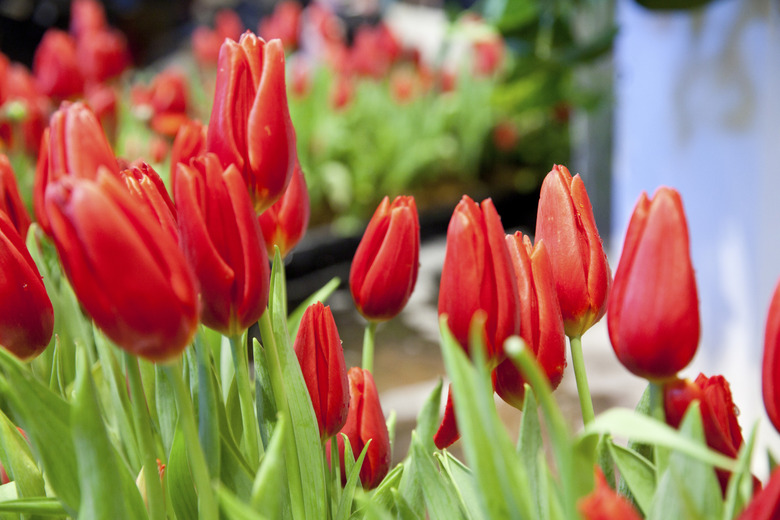How To Plant Tulips Outside After They Bloom In Pots
During the winter and early spring months many people buy or are given potted tulip plants (Tulipa spp.), which are hardy in U.S. Department of Agriculture plant hardiness zones 3 through 8. These tulips have been "forced" in nurseries, made to bloom out of season by careful manipulation of light, temperature and growing conditions. After forcing, the plant's energy, stored in the tulip bulb, is depleted. The key to successful aftercare of forced bulbs is building up the plant's energy supply once again. Forced tulips can be planted outside and will bloom again, though possibly not for a year or two.
After Bloom Care
After Bloom Care
Begin preparing potted tulips for outdoor planting as soon as the petals fade. Keep plants inside, preferably in a south- or east-facing window, at normal room temperature. Remove dead flowers, clipping the stem close to the base of the plant. Disinfect clippers before and after cutting by soaking for 5 minutes in a 50-50 solution of rubbing alcohol and water. Removing spent flowers allows the plant to put energy into the bulb, rather than seed production. Continue watering when the surface of the soil feels dry and monitor the plant's leaves. Fertilize with an all-purpose product, like 24-8-16, mixing 1/2 teaspoon per gallon of water, applied every two weeks. Do not remove the leaves until they have turned brown and brittle.
Planting in Spring
Planting in Spring
Plant the tulips outdoors any time in spring, beginning when the soil is workable. If the leaves are still green, wait until they turn brown and remove them. Choose a sunny location, preferably one that receives relatively little water in summer.
Carefully dig the bulbs out of the pot and dig a hole 8 inches deep for each bulb. Mix dirt from the holes with an equal measure of compost. Plant bulbs pointed-side up, at least 5 inches apart. Fill the holes with the amended soil, and water.
Fertilize with the same all-purpose product, using 1 tablespoon per gallon of water, applied every 14 days until the soil cools to 60 degrees Fahrenheit.
Planting in Fall
Planting in Fall
If it is not convenient to plant your tulips outdoors in the spring, you can wait until fall with an equal chance of success. After the leaves have died, remove the tulip bulbs from the soil. Place the bulbs in a brown paper bag and store in a cool, dry spot. In the fall, after the soil cools to about 60 degrees Fahrenheit, plant the tulips outdoors. Water after planting, but don't water again until after leaves appear.
Forced Tulip Considerations
Forced Tulip Considerations
Not all tulip varieties rebloom as readily as others, even with the best of care. Generally Darwin hybrids, single early and single late tulips are the best rebloomers. However, the tulips sold in pots during the winter are often not labeled as to type. Potted tulips that rebloom after being transplanted outside may bear smaller flowers than those borne in the first year inside. When planting outside, position previously potted bulbs within plantings of new tulip bulbs to ensure a good floral display even if the potted bulb never reblooms or waits until the second year after planting.
